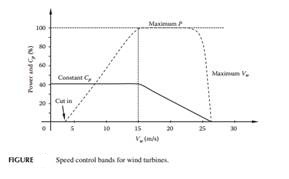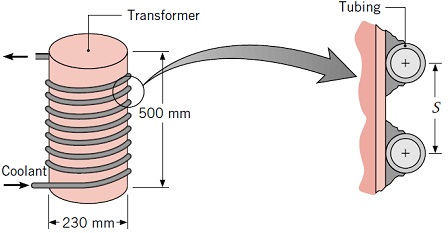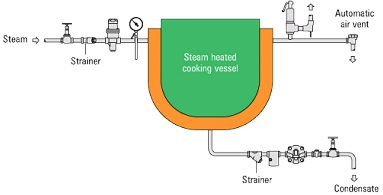Reference no: EM131282003
Fluid Flow and Heat Transfer
Question 1. The overall heat transfer coefficient of a new heat exchanger is 230 W m-2 K-1 based on an area of 14.0 m2. The heat exchanger is a shell and tube counterflow design. The hot fluid enters at 150?C and leaves at 90?C while the cold fluid enters at 20?C and leaves at 75?C. Determine the heat transfer rate between the fluids. After a few years of operation, the heat transfer is reduced due to a deposit of rust on the inside of the tube. The fouling factor of the deposit is 0.0003 m2 K W-1. Determine the heat transfer rate for this condition and calculate the percent decrease in the heat transfer rate due to the presence of the rust.
Question 2. Water flows through a shower head steadily at a rate of 10 L min-1. An electric resistanace heater placed in the water pipe heats the water from 16?C to 44?C. Taking the density of water to be 1000 kg m3 and its heat capacity to be 4200 J kg-1 K-1, determine the electric power input to the heater in kilowatts.
In an effort to conserve energy, it is proposed to pass the drained warm water at a temperature of 39?C through a heat exchanger to preheat the incoming cold water. If the heat exchanger has an overall heat transfer coefficient U = 1000 W m-2 K-1 and area 1 m2, determine the electric power input required in this case. If the price of the electrical energy is £0.12 kWh-1, determine how much money is saved during a 10 minute shower as a result of installing this heat exchanger.

Question 3. An electrical power transformer of diameter 230 mm and height 500 mm dissipates 1000 W. It is desired to maintain its surface temperature at 47?C by supplying ethylene glycol at 24?C through thin-walled tubing of 20 mm diameter welded to the lateral surface of the transformer. All the heat dissipated by the transformer is assumed to be transferred to the ethylene glycol (k = 0.252 W m-1 K-1, Cp = 2415 J kg-1 K-1, and µ = 0.0157 Pa s).

Assuming the maximum allowable temperature rise of the coolant to be 6?C, determine the required coolant flow rate, the total length of tubing, and the coil pitch S between turns of the tubing.
For the convective heat transfer coefficient for the fluid in the pipe, use the correlation
NuD = [(3.66 + 4.34/a)3 + 1.158 (ReD(D/C)1/2/b)3/2]1/3
a = 1 + 927(C/D)
b = 1 + 0.477/Pr
where C is the diameter of the helix formed by the tubing, and D is the diameter of the tubing. Note that the Reynolds and Nusselt numbers are based on the diameter of the tubing. Neglect the thermal resistance and thickness of the pipe wall.
Question 4. An electronic device that generates 30 W of heat when on has a mass of 20 g, a heat capacity of 850 J kg-1 K-1, and a surface area of 5 cm2. The device is lightly used, and it is on for 5 min and the off for several hours, during which it cools to the ambient temperature of 25?C. Taking the heat transfer coefficient to be 12 W m-2 K-1, determine the temperature of the device at the end of the 5 min operating period. What would your answer be if the device were attached to an aluminum heat sink having a mass of 200 g, heat capacity of 910 J kg-1 K-1, and a surface area of 50 cm2? Assume the device and the heat sink to be nearly isothermal.
Question 5. Hot water is used to heat a batch of 1000 kg of oil (heat capacity Cp = 1.97 kJ kg-1 K-1 and density ρoil = 910 kg m-3) from an initial temperature Ti = 15?C to a final temperature Tf = 80?C in a jacketed vessel. The heat transfer area of the jacket is 4 m2 with an overall heat transfer coefficient U = 300 W m-2 K-1. The water enters the jacket as a liquid at 100?C at a rate of 0.1 kg s-1, and the heat capacity of water is 4.2 kJ kg-1. Assume that the temperature of the batch is uniform. What time is required to heat the oil to the required temperature?
Question 6. A long roll of 2 m wide an 0.5 cm thick 1-Mn manganese steel plate (Cp = 0.49 kJ kg-1 K-1 and 8000 kg m-3) coming off a furnace at 820?C is to be quenched in an oil bath (Cp = 2.0 kJ kg-1 K-1 and 700 kg m-3) at 45?C. The metal sheet is moving at a steady velocity of 10 m min-1, and the oil bath is 8 m long. Taking the convection heat transfer coefficient on both sides of the plate to be 860 W m-2 K-1, determine the temperature of the sheet metal when it leaves the oil bath. Also, determine the required rate of heat removal from the oil to keep its temperature constant at 45?C.
Question 7. Steam at 125?C is condensed on the outside of the tubes in a shell and tube heat exchanger. Wa- ter enters the tubes at 35?C with a mass flowrate of 1.3 kg s-1. The mass flow rate of the steam is 2.5 kg s-1, and the overall heat transfer coefficient is 1650 W m-2 K-1 based on a surface area of 3.7 m2. Calculate the heat transfer rate to the water and the outlet water temperature.
The heat capacity of water is 4.2 kJ kg-1 K-1, and the latent heat of vaporization is 2188 kJ kg-1.
Question 8. A batch of 1000 kg of oil (heat capacity Cp = 1.97 kJ kg-1 K-1 and density ρoil = 910 kg m-3) is to be heated from an initial temperature Ti = 15?C to a final temperature Tf = 150?C in a jacketed vessel. The heat transfer area of the jacket is 4 m2, and the overall heat transfer coefficient is approximately U = 500 W m-2 K-1. Steam condenses in the jacket at a temperature of 200?C. Assume that the contents of the vessel are well mixed, so that the temperature of the oil is uniform.
(a) Consider the steady state operation of the system where the oil in the vessel is kept at Tf = 150?C. Hot oil at Tf = 150?C is continuously withdrawn at a rate m? oil from the vessel, and cold oil at T = 15?C is continuously added to the vessel. What is the mass flow rate of oil that can be withdrawn from the vessel?
(b) Now consider the case where the system is run in batch mode. What is the time required to heat the oil from 15?C to 150?C?

Question 9. A process water stream needs to be heated at a rate of 25,000 kg h-1 from 18?C to 65?C. It has been suggested that an existing single pass shell and tube heat exchanger might be suitable. The exchanger has 250 tubes each of 15 mm bore, 17.5 mm o.d., and 3.65 m long. Heat may be supplied by condensing an organic vapor at 96?C on the shell side with a heat transfer coefficient of 1800 W m2 K-1. The relation Nu = 0.023Re0.8Pr0.4 may be assumed on the tube side. If a fouling resistance of 0.25 m2 K kW-1 applies, determine whether this exchanger would be suitable and what the required vapor load would be.
Data:
Latent heat of vaporization of organic vapor: 430 kJ kg-1
For water at 45?C:
Thermal conductivity: 0.63 W m-1 K-1 Density: 990 kg m-3
Viscosity: 6.5 × 10-4 Pa s
Specific heat capacity: 4.18 kJ kg-1 K-1